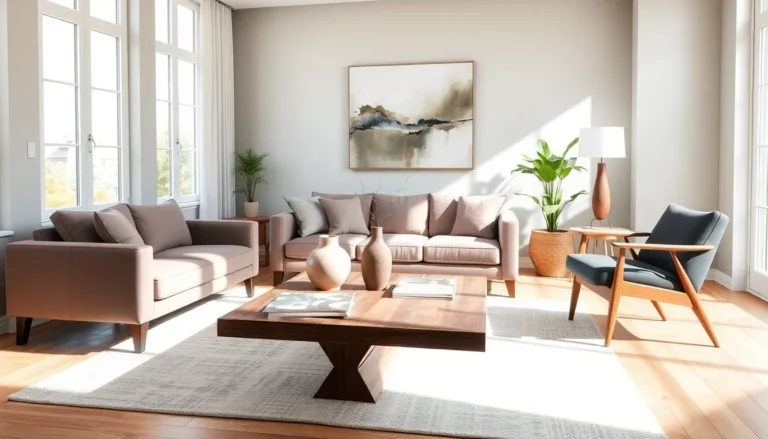Home insurance might feel like that mysterious friend who always shows up uninvited but is somehow essential to the party. It’s easy to overlook until disaster strikes, leaving homeowners wondering just how much they’ll need to fork over for peace of mind. Spoiler alert: it’s not as scary as it sounds!
Whether you’re a first-time buyer or a seasoned homeowner, understanding home insurance costs can save you from a financial hangover later. From quirky factors like your home’s age to the local raccoon population, many elements play a role in determining your premium. So, buckle up as we dive into the world of home insurance and uncover what you can expect to pay—because who doesn’t love a good financial plot twist?
Table of Contents
ToggleFactors Influencing Home Insurance Costs
Multiple factors affect home insurance costs. Understanding these elements helps homeowners make informed decisions.
Location
Location plays a significant role in determining insurance premiums. Areas prone to natural disasters, such as floods or earthquakes, often reflect higher rates. Proximity to fire departments and emergency services also influences costs, as safer neighborhoods usually yield lower premiums. Homeowners in regions with higher crime rates may see increased rates due to the elevated risk of theft or vandalism. Local building codes and regulations further impact the overall premium based on compliance requirements.
Home Characteristics
Home characteristics, including age and construction type, significantly affect insurance costs. Older homes, with outdated systems, often carry higher premiums due to increased risk of damage or repair needs. Well-built homes using durable materials also tend to enjoy lower rates. Unique architectural features might lead to higher replacement costs, influencing overall pricing as well. Safety features, like smoke alarms and security systems, can lower premiums by reducing risk assessments.
Coverage Levels
Coverage levels directly impact the final cost of home insurance. Basic policies provide essential protection, while comprehensive plans offer additional coverage at a higher price. Homeowners may opt for increased dwelling coverage to account for rising reconstruction costs. Adding personal property protection amplifies monthly premiums; however, it safeguards belongings against theft or damage. Liability coverage also contributes to premium variations by protecting homeowners from claims of injury or property damage.
Average Home Insurance Costs

Home insurance costs vary widely across the United States. Understanding these averages helps homeowners prepare for expenses related to coverage.
National Averages
The national average for home insurance costs stands at approximately $1,500 annually. This figure represents typical policies for standard coverage levels across various states, but expenses can differ based on specific circumstances. Owners of homes valued over $300,000 may pay higher premiums, often exceeding $2,000 a year. Additional factors also influence costs, such as the claims history of the owner and the insurance provider’s underwriting guidelines.
Variations by State
State variations in home insurance costs reveal significant differences influenced by numerous factors. For instance, homeowners in Louisiana experience some of the highest premiums, averaging around $2,000 annually due to climate risks like hurricanes. In contrast, states with lower risks, such as Vermont, see averages closer to $800 per year. Other factors, including local building costs and regional crime rates, further contribute to these disparities. It’s crucial for homeowners to assess their state’s unique conditions when evaluating insurance options.
Types of Home Insurance Policies
Understanding various types of home insurance policies helps homeowners make informed choices tailored to their needs. Different policies cover specific risks and property types.
HO-1 to HO-8 Explained
HO-1 offers basic coverage for specific perils like fire and vandalism, while HO-2 provides broader protection, covering more risks such as theft. HO-3 stands as the most common homeowners policy, covering the house and personal belongings against most risks. HO-4, known as renters insurance, protects personal property in a rented unit. HO-5 extends comprehensive coverage, including valuable items, with fewer exclusions. HO-6, or condo insurance, caters to those living in condominiums, covering personal property and shared structures. HO-7 serves mobile homeowners, and HO-8 addresses older homes with special coverage needs due to their unique risks.
Choosing the Right Policy
Choosing the right policy involves assessing individual needs and financial protection levels. Homeowners should evaluate their property’s value, location, and personal belongings to match policy types with specific coverage. It’s vital to compare options and examine exclusions thoroughly. Seeking advice from insurance agents can clarify complexities and enhance decision-making. Consideration of additional endorsements or riders may improve protection for high-value items or specific risks. Prioritizing local factors, including crime rates and disaster risks, further contributes to informed policy selection.
Discounts and Savings
Various discounts can significantly reduce home insurance costs. Homeowners should explore options to save on premiums effectively.
Bundling Policies
Bundling policies provides a prevalent savings strategy. Homeowners can combine home insurance with auto or other insurance types to unlock significant discounts. Many insurance companies offer up to 25% off when multiple policies are bundled. This approach simplifies management as well, allowing clients to deal with one provider for their insurance needs.
Home Safety Features
Home safety features contribute to lower premiums. Installing a security system, smoke detectors, and advanced locking mechanisms can enhance safety and lead to discounts. Insurance providers typically recognize these measures and may reduce rates by 5% to 20% based on established risk assessments. Investing in home improvements not only safeguards property but also lowers insurance costs.
Understanding home insurance costs is vital for every homeowner. By considering factors like location home age and safety features homeowners can make informed decisions that protect their investment. The average premium varies widely across states and property types so it’s crucial to assess individual needs and local conditions.
Exploring discounts such as bundling policies or enhancing home security can lead to significant savings. Ultimately selecting the right coverage involves careful comparison and consultation with insurance professionals. This proactive approach not only secures a home but also ensures financial peace of mind.






